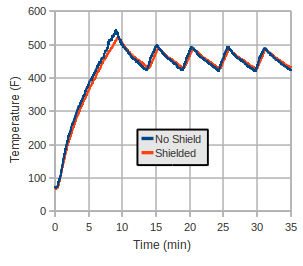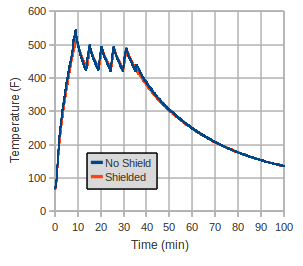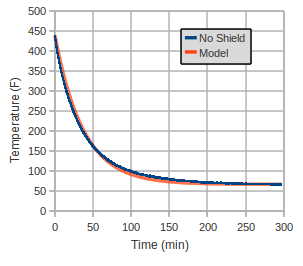I’ve got a new place with a new oven that has been consistently over-cooking my food. I could call the super, or turn the oven down or cook everything for less time, but none of that gives me an excuse to bust out my Arduino. Fortunately, I already had a (K-type) thermocouple and MAX6675 amplifier on hand that have been looking to add purpose to their lives. Using a handy Arduino library for the MAX6675 made life and coding really straight-forward.
My original intention was to simply display the oven temperature on an LCD and take readings at several oven temperature settings. I’m glad I decided to be a little more rigorous and actually record the serial data that was sent to my computer (one data point per second). As it turns out, the temperature fluctuated over a wide range, so the data records were handy. Not only was there a wide range of temperatures, but they were consistently higher than the oven setting of 400 .
This is the data taken after turning the oven on. You’ll notice a couple of things. First, the temperature oscillates pretty regularly. As far as I can tell, the heating element goes from all on to all off, contributing to the bouncing around. Also, the magnitude of the fluctuations made me suspicious that I was getting a bit of a misleading reading due to the radiation coming off of the heating element. I’d rather not expound on this too much in this post, but try holding your hand in front of your face when next to a fire. You will immediately feel cooler; most of the heat you from a fire (an outdoor one, anyway), is radiative. This temperature does not reflect the air temperature; this is why you put a thermometer in the shade.
 Anyway, I thought this might be contributing to an elevated temperature reading, so I put a piece of aluminum foil between the thermocouple and the heating element at the bottom of the oven. The foil was intended to block the radiation from the red hot heating element. I tend to believe this worked; it’s not as if the foil got red hot (~1500
Anyway, I thought this might be contributing to an elevated temperature reading, so I put a piece of aluminum foil between the thermocouple and the heating element at the bottom of the oven. The foil was intended to block the radiation from the red hot heating element. I tend to believe this worked; it’s not as if the foil got red hot (~1500 ), but obviously, it made little to no difference in the temperature reading. So either this radiative heating was never or factor, or I am making a mistake.
After 35 minutes, I turned the oven off, just to see how it cooled off:
This looked like something that maybe I could model… In fact, recalling some of my heat transfer book-learnin’, I figured the best way to start would be to treat the oven as a lumped capacitance system (insert spherical cow joke here). I didn’t have my old textbook on hand, so I fell back on Wikipedia, which provided me with a nice equation for the expected exponential decay:
A characteristic time of 0.00045 seemed to do a nice job of matching the theory to the model:
Not bad.
I did these tests two different days; I was actually shocked at how consistent the temperature histories are! The oven may be wrong, but it’s wrong consistently, which means I should be able to learn to use it without burning everything. I guess a potential next test would be to do this analysis at various oven setting and observe what the results are so that I have a consistent adjustment to cook my food appropriately.
At the end of the day, I’m wondering what my oven is doing wrong. Is the feedback (a thermocouple, I presume) mis-calibrated (assuming mine is accurate…)? Where is it placed? Perhaps it’s measuring temperature in a location not particularly relevant to the oven center. Questions for another day…



